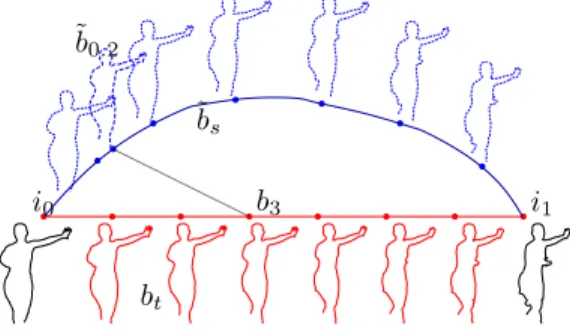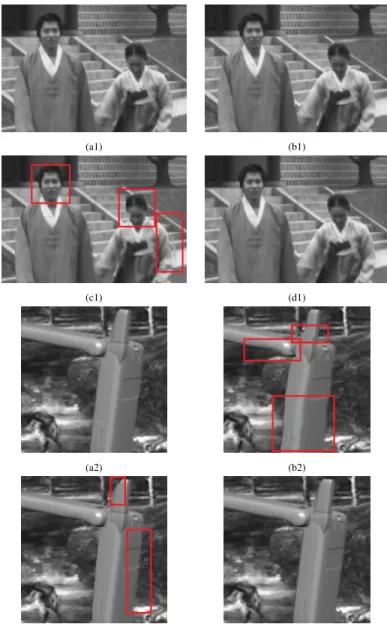HAL Id: hal-01423653
https://hal.archives-ouvertes.fr/hal-01423653
Submitted on 9 Jan 2017
HAL is a multi-disciplinary open access
archive for the deposit and dissemination of
sci-entific research documents, whether they are
pub-lished or not. The documents may come from
teaching and research institutions in France or
abroad, or from public or private research centers.
L’archive ouverte pluridisciplinaire HAL, est
destinée au dépôt et à la diffusion de documents
scientifiques de niveau recherche, publiés ou non,
émanant des établissements d’enseignement et de
recherche français ou étrangers, des laboratoires
publics ou privés.
Depth coding and perceived quality for 3D video
Marco Calemme, Marco Cagnazzo, Béatrice Pesquet-Popescu
To cite this version:
Marco Calemme, Marco Cagnazzo, Béatrice Pesquet-Popescu.
Depth coding and perceived
quality for 3D video.
QoMEX 2015, May 2015, Costa Navarino, Greece.
pp.1 - 2,
Depth coding and perceived quality for 3D video
Marco Calemme, Marco Cagnazzo, Senior Member, IEEE, and Beatrice Pesquet-Popescu, Fellow, IEEE
Abstract—Multi-view video plus depth is emerging as the most flexible format for 3D video representation, as witnessed by the current standardization efforts by ISO and ITU. The depth information allows synthesizing virtual view points, and for its compression various techniques have been proposed.
We make a preliminary investigation of the effects on the synthesized views of two different approaches: object-based and block-based, from a perceptual point of view.
Index Terms—perceived quality, 3D video, multiple-views-plus-depth, contour coding, elastic curves.
I. INTRODUCTION
The video-plus-depth representation for multi-view video sequences (MVD) consists of several views of the same scene with their associated depth information, which is the distance from the camera for every point in the view [1]. Depth information allows synthesizing virtual view points, for such applications as 3D television and free-viewpoint video, but it requires ad-hoc compression technique, since those developed for texture images are not well suited for depth. As a consequence, MVD compression has attracted a huge amount of research effort in the last years, while ISO and ITU are jointly developing an MVD coding standard [2].
A key point in depth images compression is that they are not meant to be visualized but only used for rendering of virtual views. Various techniques have been specifically proposed to code the depth information associated to the views. Recent approaches include object-based coding of depths. Calemme et al. [3] proposed a technique using elastic deformation of curves to losslessly encode the object contours, and shape-adaptive wavelet to represent the inner parts of the objects. This techniques proved to be competitive with state-of-the-art approaches in terms of objective quality metrics (PSNR and SSIM). In this article we shall investigate the perceived video quality of synthesized views obtained with the use of depth maps coded with the technique described in [3] and we will make comparisons with HEVC/Intra.
II. CODING OF DEPTH MAPS
The depth map compression technique described in [3] is composed of two different parts: a lossless coding technique that uses elastic curves as inter-frame predictor is used for the contours of the objects; and a object-based coding technique for the interior part of the objects.
Lossless contour coding using elastic curves. Srivastava et al.[4] introduced a framework to model a continuous evolution of elastic deformations between two reference curves. The referred technique interpolates between shapes and makes the intermediary curves retain the global shape structure and the important local features such as corners and bends. The elastic
deformations along two given curves (Fig. 1) reproduces very well the deformations related to a change of viewpoint or a temporal evolution of an object in a sequence, given the initial and final shapes.
˜ b0.2 i0 b3 i1 ˜b s bt
Fig. 1. Geodesic path of elastic deformations ˜bsfrom the curve i0to i1(in
dashed blue lines). b3is one of the contours btextracted from the intermediate
frames between the two reference ones, a good matching elastic curve ˜b0.2
along the path is highlighted.
Supposing that the encoder and the decoder share a repre-sentation of the initial and final shape, they can reproduce exactly the same geodesic path between them. Then, the decoder will use a suitable point of the geodesic, i.e. one of the dashed curves in Fig. 1, as context to encode an intermediary contour (one of the solid curves in the same figure). The encoder will only have to send a value in [0, 1] to let the decoder identify this curve. The lossless coding of the contour is performed through an arithmetic coder, and the input symbol probability distribution is modified on the fly according to the elastic prediction [3].
Object-based depth maps coding technique. The lossless contour coding technique can be used to create a segmentation map of the scene with different objects and use this map in conjunction with an object-based coding technique. The proposed method [3] relies on the SA (Shape Adaptive) Wavelet Transform, followed by SA SPIHT (Set Partitioning In Hierarchical Trees), followed by an arithmetic coder for the SPIHT symbols (memoryless, without context). This provides an entirely Intra technique for the inner part of the objects. Advantages/drawbacks of lossless coding. The validity of the object-based approach is suggested by the relevance of the contour information in the synthesis step. However, a minimum bit budget is needed for a lossless representation of contours. This initial cost may be a relevant fraction of the total rate dedicated to the depth map. The question that arises is if the benefits of a lossless contour will actually be perceived as relevant against its bit-rate cost. Therefore we propose in this work an alternative depth coding method: the
elastic prediction itself is used to generate the segmentation map to feed the object-based coder. The lack of precision of the elastic prediction is compensated by the fact that it is possible to lower the rate dramatically, at the price of a quality which can be acceptable for very low bit rate video.
III. COMPARISONS
The multiview sequences lovebird (provided by the ETRI/MPEG Korea Forum) and mobile (Philips) have been used for tests. We coded the depth maps with the technique proposed in [3], HEVC in mode Intra, and also the new method with contour prediction (instead of contour coding). We show for the two sequences the different kind of artifacts corresponding to each coding method.
Objective measurements and perceived quality. At very low bit-rates there is a non negligible difference in terms of PSNR, as shown in Fig. 2. The difference is due to the high sensitivity of the PSNR to pixel shifts, which are the result of the different geometry of the compressed scene: even if the contour is perfect, at low bit rates the inner part is very coarsely coded.
0 2000 4000 6000 8000 10
20 30
Average rate [bits]
A v erage PSNR [dB] HEVC Intra Method [3] New 0 500 1000 1500 2000 10 20 30 40 50
Average rate [bits]
A v erage PSNR [dB] HEVC Intra Method [3] New
Fig. 2. PSNR comparison for lovebird (left) and mobile (right).
To make a visual comparison between the different tech-niques we show in Fig. 3 some image crops of the synthesized views obtained using depth maps compressed with the three techniques. HEVC/Intra is used at QP 51, the technique proposed in [3] at the lowest possible bit-rate, and the proposed technique at the same bit-rate: we want to evaluate if it is really worth to losslessly encode the contour or we can rely on the SA Coder to compensate for the imprecision. We performed a preliminary subjective test (DSIS) with 6 naive subjects and, although the differences in PSNR at low bit-rate are not negligible (see in Fig. 2), the artifacts introduced by the technique of [3] are more acceptable to the human eye: the MOS is 4.08 at the rate of 0.0019 bits per pixel, while it is 3.42 at 0.0024 bits per pixel for HEVC and 3.33 at 0.0018 bits per pixel for the new method.
In Fig. 3 the noteworthy details are highlighted with red rectangles. In fact a pixel shift is barely noticeable as we can see in Fig. 3(d1) and (d2) and (b1), which is a rare case where the predicted elastic contours are very close to the original ones. On the other hand fragmented contours, like in (b2) and (c2), or ringing effects (c1) are usually perceived as annoying. The complete test images are available at the authors’ web site: http://calemme.wp.mines-telecom.fr/?p=5. Conclusions. We have shown typical images for low bit-rate depth coding, casting the attention on the resulting artifacts.
(a1) (b1)
(c1) (d1)
(a2) (b2)
(c2) (d2)
Fig. 3. Cropped detail of the synthesized view of the sequences lovebird (1) and mobile (2): (a) is the reference, obtained by the uncompressed depths; (b) is the new method; (c) is relative to the depths compressed by HEVC Intra; (d) to the method described in [3].
Given the resulting synthesized images, it seems that a contour close to the object can lead to visible benefits. However further subjective tests are needed to assess the degree of acceptance of the different techniques in various conditions.
REFERENCES
[1] F. Dufaux, B. Pesquet-Popescu, and M. Cagnazzo, Eds., Emerging technologies for 3D video: content creation, coding, transmission and rendering. Wiley, 2013.
[2] “Call for proposals on 3D video coding technology,” ISO/IEC JTC1/SC29/WG11, Geneva, Switzerland, Tech. Rep., Mar. 2011, doc. N12036.
[3] M. Calemme, M. Cagnazzo, and B. Pesquet-Popescu, “Lossless contour coding using elastic curves in multiview video plus depth,” Asia-Pacific Signal and Information Processing Association, 2014.
[4] A. Srivastava, E. Klassen, S. H. Joshi, and I. H. Jermyn, “Shape analysis of elastic curves in euclidean spaces,” IEEE Trans. Pattern Anal. Machine Intell., vol. 33, no. 7, pp. 1415–1428, Sep. 2010.

